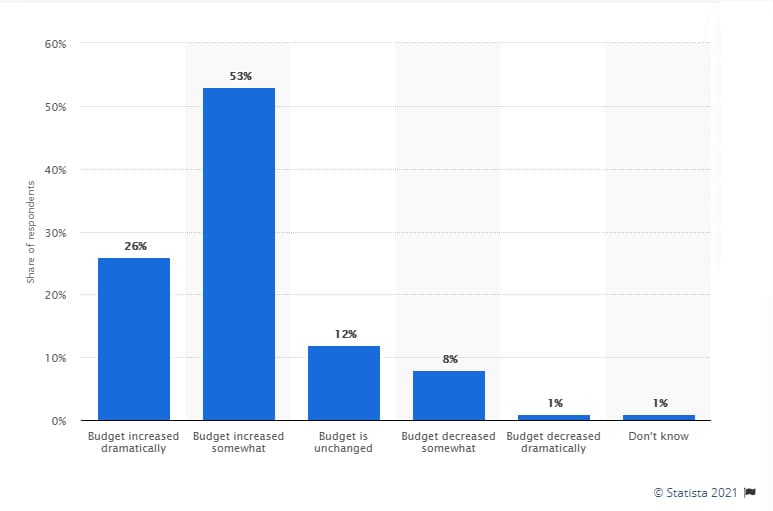The Veeam Data Protection Report 2021 claims that COVID-19 has “significantly impacted Digital Transformation (DX) spending, with 40% of global organisations viewing economic uncertainty as the greatest barrier to DX in the next 12 months and one-third having slowed or halted initiatives in the past year.”
This goes against a February 2021 Statista survey that noted technology budgets related to digital transformation may have grown in 2020-2021 with 79% of respondents a rise in budgets compared to 12% unchanged and 9% seeing a decline.

But likely the disparity is in the sample group (APAC vs global), methodology, the purpose of the study (DX vs data protection), etc.
Veeam’s study noted that data protection challenges are undermining organisations’ abilities to execute Digital Transformation (DX) initiatives globally.
In a separate article, the Boston Consulting Group (BCG) also noted that COVID-19 may be accelerating digital transformation imperatives with 80% of participants in the study saying that “digital was helping them get through the economic slowdown created by the pandemic.”

In a press release, Veeam concluded that against the backdrop of COVID-19 and ensuing economic uncertainty, which 40% of CXOs cite as the biggest threat to their organisation’s DX in the next 12 months, inadequate data protection and the challenges to business continuity posed by the pandemic are hindering organisations’ initiatives to transform.
Acknowledging the COVID-19 condition, Danny Allan, chief technology officer and senior vice president of product strategy at Veeam, commented that over the past 12 months, CXOs across the globe have faced a unique set of challenges around how to ensure data remains protected in a highly diverse, operational landscape.
He opined that the way data is managed and protected continues to undermine them. “Businesses are being held back by legacy IT and outdated data protection capabilities, as well as the time and money invested in responding to the most urgent challenges posed by COVID-19. Until these inadequacies are addressed, genuine transformation will continue to evade organisations,” warned Allan.
Urgent action on data protection required
Respondents stated that their data protection capabilities are unable to keep pace with the DX demands of their organisation. This poses a threat to business continuity and potentially leading to severe consequences for both business reputation and performance.
Despite the integral role backup plays in modern data protection, 14% of all data is not backed up at all and 58% of recoveries fail, leaving businesses’ data unprotected and irretrievable in the event of an outage by cyberattack.
Furthermore, unexpected outages are common, with 95% of organisations experiencing them in the last 12 months; and with one in four servers having at least one unexpected outage in the prior year, the impact of downtime and data loss is experienced all too frequently.
Allan cited the two reasons for the failed backup and restore success: Backups are ending with errors or are overrunning the allocated backup window, and secondly, restorations are failing to deliver their required SLAs.
“Simply put, if a backup fails, the data remains unprotected, which is a huge concern for businesses given that the impacts of data loss and unplanned downtime span from customer backlash to reduced corporate share prices. Further compounding this challenge is the fact that the digital threat landscape is evolving at an exponential rate. The result is an unquestionable gap between the data protection capabilities of businesses versus their DX needs,” said Allan.
Other highlights
- Hybrid IT across physical, virtual and cloud: Over the next two years, most organisations expect to gradually but continually reduce their physical servers, maintain, fortify their virtualized infrastructure, and embrace “cloud-first” strategies. This will result in half of production workloads being cloud-hosted by 2023, forcing organisations to re-imagine their data protection strategy for new production landscapes.
- Rapid growth in cloud-based backup: Backup is shifting from on-premises to cloud-based solutions managed by a service provider, with trajectory reported from 29% in 2020 to 46% anticipated by 2023.
- Importance of Reliability: “To improve reliability” was the most important driver of a global organisation to change its primary backup solution, stated by 31% of respondents.
- Improving ROI: 22% stated that the most important driver for change was improving the economics of their solution. This includes improving ROI/TCO and reducing.
- Availability Gap: 80% of organisations have an “availability gap” between how fast they can recover applications and how fast they need to recover them.
- Reality Gap: 76% have a “protection gap” between how frequently data is backed up versus how much data they can afford to lose after an outage.
- Modern Data Protection: 46% of organisations globally will partner with a Backup as a Service (BaaS) provider by 2023 while 51% plan to adopt Disaster Recovery as a Service (DRaaS) in the same timeframe.





